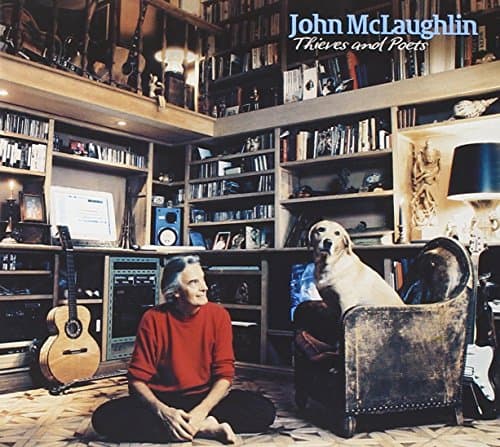
John McLaughlin Thieves And Poets
Value For Money
John McLaughlin Thieves And Poets
When you purchase through links on our site, we may earn an affiliate commission. Here's how it works.

User Reviews
Value For Money
There Are Innevitable Parallels To Be Made Between
There are innevitable parallels to be made between 1986's Mediterranean Concerto and John McLaughlin's new classical composition Thieves And Poets. They are both symphonic, each comprising 3 parts for guitar with symphony orchestra. They both span European and New World influences. They are both incredibly brilliant classics given the jazz oriented background of their composer.
So why does John feel the need to reach out into these new directions when he could maintain a quite comfortable position in more familiar territory? For John it is the journey through musical lands that holds the key. Embracing the transience of his own creativity has enabled an unsurpassed opportunity for new collaboration and invention of musical style. The two are not necessarily mutually exclusive, and John knows it.
You learn from everybody and you adopt the attitudes and techniques and make them your own. It's not for nothing the new CD is called "Thieves and Poets". We're all thieves. I'm the biggest thief of all, I've been stealing all my life. We call it being influenced, but it's basic appropriation. You can try to do it other people's way, but in the end, you can only do it your way. Every now and then you can say something of value. It doesn't happen every day, but it's the life's work, isn't it?
True, that it is no coincidence that individuals metamorphose in response to the playing of their peers, but it takes a maestro to maintain a sound all of their own at their core throughout such change.
Apart from his fiery modal runs, even when McLaughlin turns his hand to something that at first seems as alien as classical composition, there are trademark signposts that reassure us that it is him. Both The Meditarranean and Thieves And Poets are riddled with soundbite clues. Mahavishnu blues pervaded The Meditarranean. Shakti's India features the first movement of Thieves And Poets, and Mingus' Goodbye Pork Pie Hat is quoted in the second, which also opens with an arrangement of Blues for LW.
Similar to The Meditarranean, Thieves And Poets exudes an overall feel of Copland's grandeur and the theatrical drama of Bernstein. The tamboura-like drone lifts a gentle introduction into a fusion of Shaktiesque alap with Mediterranean flamenco decoration and Western military bugle call. The geographical dictionary is defined from which the musical vocabulary will be drawn. Motifs are set and echoed fugue-like across the arrangement, harmony and counterpoint is the composer's focus; scaling from delicate conversations between guitar and soloist, up to orchestra and guitar. The music emerges from the combinatorial interactions brought into play, usually found in a dynamic body such as a jazz quartet. Guitar and violin leap and glide together like star-crossed lovers. Blocky string sections explode to send the quieter background-bubbling string sections racing onto their next phrase. Sublime soliloquies nestle within the rich womb-warm arrangements. Open vistas are painted impressionist. Home fires are signalled by familiar passages creeping onto the corners of the enormous canvas. We stare star-ward into a limpid nightsky, dwarfed by the size of it all.
Genius. Pure genius in the realm of great contemporary classicists, but also with the acetic energy and drama of Goldsmith's movie scores.
Weaknesses? There are few. But the crass 'church organ' arrangement for the chord finale in Part 3 is an anticlimax, when a less pompous exeunt would have better matched the preceding tonal centre.
The cover art cannot be ignored. A great design capturing the maestro relaxing at home with Skip in his den/library/studio. A wonderful glimpse of the private man matched by a personal interpretation of the music in the liner notes. Though, hard to believe that he would have misspelt Aranjuez as 'Aruanjez'.
The four standards that follow the symphony are performed with the Aighetta Quartet in the style of Time Remembered, and they are wonderful. Without the shimmering reverb of the previous album the sound is truly acoustic, warm and beautiful. Each is dedicated to a pianist who has had influence. Harmonic contrasts abound in the piece dedicated to Hancock, "Stella by Starlight", and the future of jazz is heralded by "The Dolphin" dedicated to rising star Gonzalo Rubalcaba. This is some of John's most passionate playing we have heard in a while.
Q&A
There are no questions yet. Be the first to ask a question.